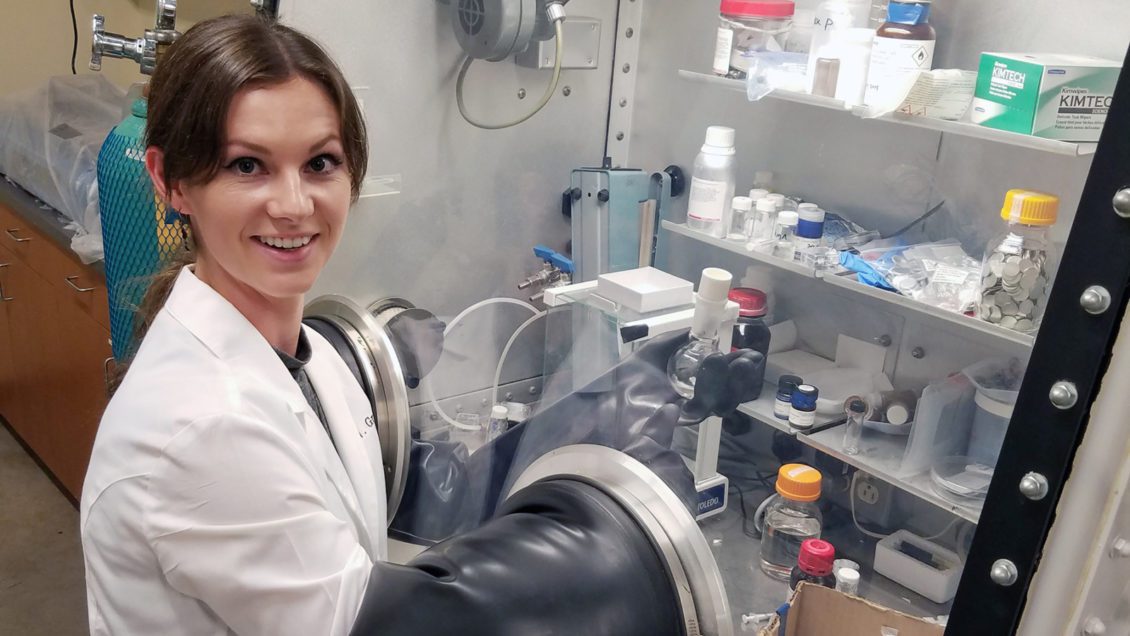
CLEMSON, South Carolina – Understanding how a process works – not just that it does – is a critical step that can provide the framework for practical applications far beyond the lab.
Scientists from the Clemson Nanomaterials Institute (CNI) have discovered the mechanism behind how graphene inhibits the formation of abnormal fibrous protein-rich deposits found in organs and tissues called amyloids that play a deleterious role in several diseases. This discovery could have a profound impact on the future treatment of conditions such as Alzheimer’s disease, Type 2 diabetes and abdominal aortic aneurysms.
Collaborative research conducted by assistant professor Ramakrishna Podila and Ph.D. candidates Wren Gregory and Bipin Sharma of the College of Science’s department of physics and astronomy was recently published in the journal Biointerphases. The article titled “Interfacial charge transfer with exfoliated graphene inhibits fibril formation in lysozyme amyloid” also included a pair of authors, Longyu Hu and Achyut Raghavendra, who are former Clemson graduate students.
This new study revealed that the interfacial charge transfer interactions between proteins and graphene might be the key. Podila explained that proteins have different conformations.
“Proteins have different structures. They have coils, like the old telephone wire,” he said. “What happens in diseases like Alzheimer’s is these proteins unfold and begin combining with each other and then form plaque. It’s been known for a while that stopping this formation can be helpful in controlling the disease itself.”
Gregory, senior doctoral candidate at CNI, was first author on the paper, which describes how proteins unfold and misform.

“Sometimes internal portions of these proteins that would typically be rolled up inside and not in contact with the surrounding chemical environment can become exposed, which can lead to a host of chemical and physical interactions between neighboring proteins as they bind together, or aggregate,” Gregory explained. “This is how many of these diseases progress – or at least this is what we think is a main contributing factor.”
The team used the protein lysozyme from egg whites as a model protein and used graphene, a one-atom thick layer of carbon with a honeycomb structure, to stop the formation of plaque. Gregory said that graphene is a model material for this kind of research because its structure is simple and purely aromatic. The honeycomb structure and its physiochemical consequences are known as aromaticity in physics and chemistry, which is a key factor in these interactions.
“We can study these interactions in as close to a ‘pure’ environment as possible, versus a more complex material where many different chemical interactions are taking place that can make it difficult to study and discern,” Gregory said. “We looked at how graphene interacted with lysozyme when it was in an amyloidal and fibril forming environment and found out that graphene actually dramatically reduced those fibrils, which we confirmed using spectroscopy and transmission electron microscopy.”
“We are not the first ones to show that graphene stops the plaque formation, but the mechanism by which this is happening was unclear,” Podila said. “What we tried to do was not cure the disease, but rather figure out the mechanism for stopping the plaque formation.”
And they succeeded, showing that charge transfer is the key.
“Some of the electrons from graphene are transferred to the proteins and when that happens, we found that the plaque formation stops,” Podila said.
Confirmation that the graphene and proteins were sharing electrons came through different means. The team employed micro Raman spectroscopy, which does not provide a visual picture but does denote a spectroscopic signature for the material. This spectroscopic signature is a special signature of vibrational energy states within a material that denote the available states of its electrons – hence, charge transfer.
“When you hit a material with light, the material vibrates at different frequencies, like a bell ringing with different frequencies,” Podila said, “Raman spectroscopy gives us a glimpse into those different frequencies.”
Fluorescence spectroscopy was used to detect protein unfolding. Atomic Kelvin probe force microscopy, which is a form of atomic force microscopy that also monitors the electrical environment of a surface through a voltage plot, was used to visually map where the charges were moving and further confirm the charge transfer.

“Previously, charge transfer was not considered,” Podila said. “We were able to pinpoint the mechanism. We were able to get down to the details of it using Raman spectroscopy and atomic force microscopy. We combined three different techniques. For the first time, we were able to observe charge transfer between graphene and amyloids.”
Podila said the research is in its early stages but potentially has far-reaching implications. Other studies have shown graphene to be safe, so future research will build upon this understanding of the mechanism, eventually looking at dosage and which conditions could be treated or prevented.
For now, the work continues. Gregory, who is finishing her studies at Clemson, said one of the most challenging parts of researching at the Nanomaterials Institute is deciding what path to take, since so many are available.
“You can get a lot of different experiences with state-of-the-art equipment and some of the best scientific minds in those fields,” she said.
The study was funded by the National Institutes of Health’s National Institute of Environmental Health Sciences under grant number 5R01ES019311-09.
Get in touch and we will connect you with the author or another expert.
Or email us at news@clemson.edu

